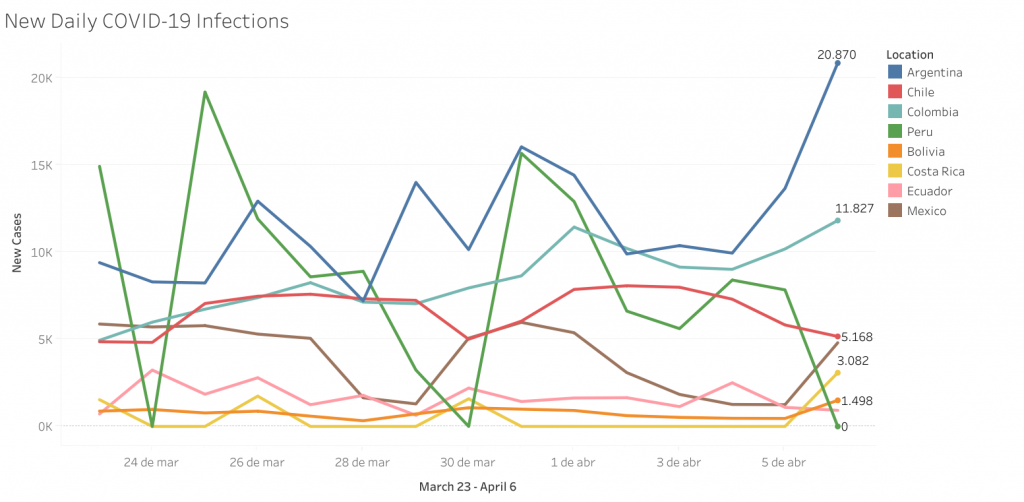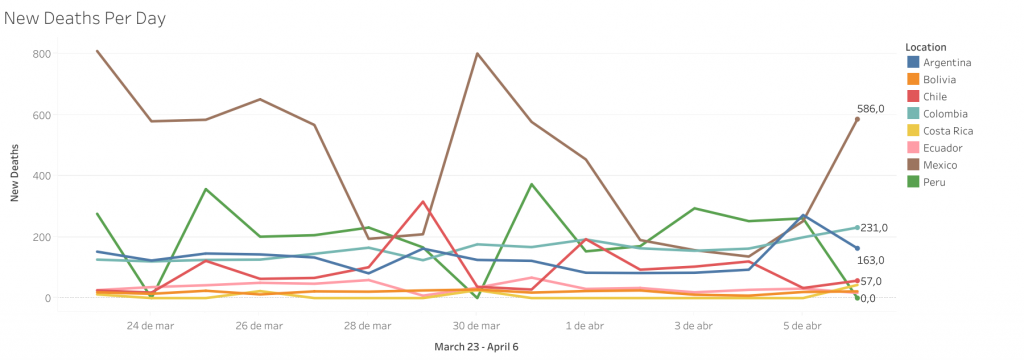What You Should Know
- Peru: On April 3, Peru registered its highest single-day COVID-19 death toll, ahead of this weekend’s presidential and parliamentary elections.
- Labor formalization: The Inter-American Development Bank says labor formalization will be critical to encouraging inclusive growth post-pandemic. Before the pandemic struck, between 50 percent to 60 percent of LAC workers — some 150 million people — worked in the informal sector.
- Environmental defenders: Twelve regional governments have ratified the Escazú Agreement — a treaty formally protecting the lives and rights of environmental defenders — including Mexico, Argentina, Antigua & Barbuda, Guyana, St. Vincent, St. Kitts, and Nevis, St. Lucia, Bolivia, Ecuador, Nicaragua, Panama, and Uruguay. The Agreement will come into full force on April 22, 2021.
- 25 million: On April 2, Latin America and the Caribbean passed the 25 million mark for recorded COVID-19 cases. Here are this week’s figures.
Health + Innovation
- 1 million: According to PAHO Director Dr. Carissa Etienne, the Americas have reported an average of nearly one million new COVID-19 infections per week.
- Brazil: Although approximately 10 percent of Brazilians have received the first vaccine dose, intensive care units in twenty-five of twenty-seven states remain at over 80 percent capacity.
- Peru: The country has the second-highest mortality rate in the world, only behind Mexico, and is only administering a few thousand vaccine doses each day. At this rate, herd immunity through inoculation would take more than a decade to achieve.
- Argentina: President Alberto Fernández tested positive for COVID-19 on April 2, a little over two months after receiving the Sputnik V vaccine. President Fernández reported a fever and headache among his symptoms.
- Mexico: On April 5, President Andrés Manuel López Obrador said that he will not get a COVID-19 vaccine because, according to his doctors, he has a high level of antibodies from when he was infected in January. A day later, López Obrador reversed his statement and said that he will get vaccinated “to set an example” for the country. Foreign Minister Marcelo Ebrard will visit Russia and China as part of his government’s efforts to ensure vaccine supply agreements are fulfilled.
- Panama: The Ministry of Health approved the emergency use of the Sputnik V vaccine. Panama will purchase three million doses.
- Haiti: As of April 6, Haiti has not received a single COVID-19 vaccine dose. The country of 11 million people is expecting only 756,000 doses of the AstraZeneca vaccine through the COVAX facility to cover 20 percent of its population. The first batch was scheduled to arrive in May, but the government has missed several key deadlines to submit the necessary documentation to receive the vaccines, resulting in indefinite delays.
Economies in Focus
Multilateral Analysis
- The World Economic Forum’s Global Gender Gap Report estimates that the pandemic has set back gender equality by thirty-six years as women have been disproportionately impacted by the pandemic.
- The IMF improved its growth projections for the global economy estimating 6 percent growth for 2021, due to the improved forecasts for advanced economies, especially the United States.
- IMF Head of Fiscal Affairs Vitor Gaspar suggested that a temporary tax on businesses and high earners would strengthen social cohesion even if the tax is not necessary to improve public finances.
Economic Relief
- The World Bank approved $150 million in additional financing for Ecuador’s response to the COVID-19 pandemic. The funds will be used to purchase and distribute vaccines and to support pandemic management.
Economic Impact
- Foreign direct investment in Latin America fell by 90 percent in 2021, according to a study conducted by ICEX Invest in Spain.
- Argentine e-commerce giant Mercado Libre announced that it will double its workforce this year and invest $1.1 billion to expand warehouse spaces and services in Mexico as the pandemic drives an online shopping boom.
Quarantines + Travel Restrictions
Quarantines + Reopenings
- Colombia announced new restrictions amid a third COVID-19 wave. For cities with ICU occupancy greater than 50 percent, ID-based shopping procedures will be reinstated as will nightly curfews; restrictions are more drastic in cities with higher ICU occupancy rates. The measures will remain in place until at least April 19.
- Bolivia announced that travelers must have health insurance and present a negative PCR test conducted no more than 72 hours before their flight and complete a 10-day quarantine upon arrival. On the seventh day, travelers will be subjected to another PCR test.
- Chile began a new curfew on April 5, from 9:00 p.m. until 5:00 a.m., and announced new restrictions on movement, a more limited definition of essential services, and restrictions on the sale of certain goods in areas where there is a high prevalence of COVID-19.
- Cuba strengthened measures to slow the spread of COVID-19, including further limiting the movement of people and increasing enforcement of fines for failing to use a mask or comply with social distancing measures.
- Ecuador declared a 30-day state of emergency and a nightly curfew from April 2 until April 9 in eight provinces.
Border and travel restrictions
- Beginning April 5, Chile closed its borders to citizens and tourists until May 1 amid a new wave of COVID-19 cases.
- Bolivia closed its border to Brazil from April 2 to April 9 due to concerns over the P.1. COVID-19 strain.
In Focus: Vaccine Diplomacy
- The United States appointed Gayle Smith as the coordinator of the global COVID-19 response and health security at the State Department, a sign of US commitment to ensure equitable vaccine distribution around the world.
- Several Latin American and Caribbean countries have asked the United States for vaccine donations or criticized its lack of support to the region, including Argentina, Mexico, Colombia, Trinidad and Tobago, St. Kitts and Nevis, and Antigua and Barbuda.
- As the geopolitics of vaccine and pandemic assistance play out, don’t miss our up-to-date Latin America and the Caribbean COVID-19 vaccine tracker, a set of interactive maps that track: 1) the percentage of the population of each Latin American and Caribbean country covered by current vaccine agreements; 2) the total number of doses secured by each country and breakdown by supplier/vaccine; 3) where each vaccine is being used across the region; and 4) how many vaccines flow from each major producing country to regional destinations.
By the numbers
- Cases by country: Brazil (13,106,058) #2 worldwide, Colombia (2,468,236) #12 worldwide, Argentina (2,428,029) #13 worldwide, Mexico (2,256,380) #14 worldwide, Peru (1,598,593) #17 worldwide, Chile (1,037,780) #22 worldwide, Panama (356,913) #45 worldwide, Ecuador (337,702) #47 worldwide, Bolivia (276,890) #53 worldwide, Dominican Republic (254,937) #58 worldwide, Source: worldometers.info
- Prevalence rate (total cases per million people: Aruba (91,120) #9 worldwide, Panama (81,741) #15 worldwide, Curacao (61,875) #40 worldwide, Brazil (61,326) #41 worldwide, Chile (53,935) #51 worldwide, Argentina (53,349) #52 worldwide, Colombia (48,117) #57 worldwide, Peru (47,975) #58 worldwide, Costa Rica (42,858) #64 worldwide, Saint Martin (42,357) #65 worldwide, Uruguay (35,333) #71 worldwide, Source: worldometers.info
- Deaths per capita (deaths per million people): Peru (1,603) #17 worldwide, Brazil (1,579) #18 worldwide, Mexico (1,577) #19 worldwide, Panama (1,408) #25 worldwide, Colombia (1,258) #30 worldwide, Argentina (1,244) #31 worldwide, Chile (1,233) #32 worldwide, Bolivia (1,048) #37 worldwide, Ecuador (953) #42 worldwide, Aruba (850) #47 worldwide, Belize (789) #51 worldwide, Source: worldometers.info
Quick take


